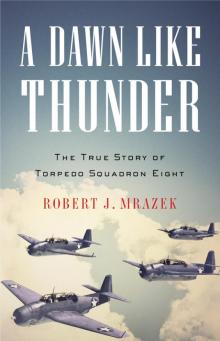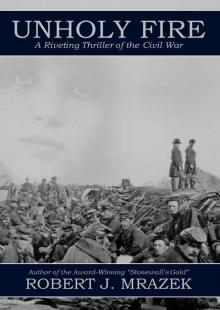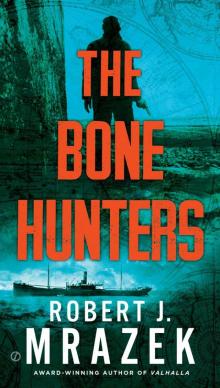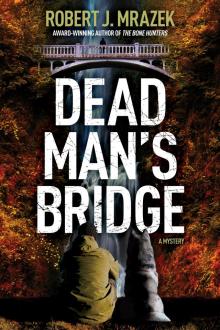- Home
- Robert J. Mrazek
A Dawn Like Thunder Page 2
A Dawn Like Thunder Read online
Page 2
When the breeze dropped, Morgan smelled the reek of crude oil mixed with the fetid water seeping out of the ships. Along with the stench of the oil, he could smell something else.
“Hundreds of guys never made it out of the ships,” said one of the officers at the deck railing. “They’re all still down there.”
Beyond the ships, the cluttered shoreline was fouled by almost a foot of sludge. A slew of dead birds were snared in the coils of barbed wire that had been strung along the beach in the days after the attack.
Suddenly, another shout went up and Morgan turned in time to see a gigantic aircraft carrier towering high above one of the Pearl Harbor dry docks. At ten stories, the ship’s island almost blocked out the landscape. Hundreds of workers were swarming over her, the flash of their torches arcing brightly across the water. Along with the welders and steamfitters, Morgan could see electricians crawling past fire-blistered hatches and torn bulkheads, and dragging heavy electrical cables behind them. It reminded him of the scene in Gulliver’s Travels in which the Lilliputians frantically tied down the giant with heavy hawsers.
“It’s the Yorktown,” someone shouted as the Chaumont nosed into its pier at Ford Island and came to a stop.
The Yorktown was one of the three American carriers left in the Central Pacific after the Japanese had sunk the Lexington a month earlier. But where were the Hornet and the Enterprise? Morgan wondered as he anxiously scanned the rest of the anchorage. The other two carriers weren’t in sight.
Across the dock, antiaircraft batteries were dug in behind mounds of sandbags. Armed military policemen carrying gas masks were manning a roadblock at the gatepost to Luke Airfield, which occupied most of Ford Island.
Carrying their overseas bags, the seventeen pilots of Torpedo Squadron Eight disembarked from the ship. Lieutenant Harold “Swede” Larsen, the strapping blond Annapolis graduate temporarily in command, was waiting for them near the foot of the gangway with Lieutenant Langdon Fieberling, the second-highest-ranking officer in their detachment. The pilots gathered in a loose circle.
Larsen told Fieberling to take them over to the Bachelor Officers’ Quarters and wait for him there, while he went to find out where Lieutenant Commander Waldron and the rest of the squadron were.
They set off on foot across Ford Island carrying their bags. As they passed the transport ship Hammondsport, a crane was already extracting one of their new, bluish gray Grumman Avengers from the ship’s hold. The torpedo plane rose slowly into the air above them, its retractable wings folded back along the fuselage like a dozing mallard’s.
At the gatepost to Luke Field, Lieutenant Fieberling had to produce his Navy identity card before they were allowed through. When they came to the first hangar at the edge of the airfield, Morgan saw that it had been reduced to a steel skeleton by Japanese bombs. A bulldozer was scraping together a massive pile of charred timber, concrete rubble, and airplane parts.
They found the Bachelor Officers’ Quarters at the end of the runway near the northern tip of the island, its once manicured lawn scarred by newly dug slit trenches. Inside the crowded lobby, the officers dropped their overseas bags and immediately headed toward the bar.
The manager stepped forward to tell Fieberling that the new facility was full. There were men already sleeping in the corridors, he said apologetically. The detachment was welcome to eat its meals there, but that was all the BOQ could provide.
“Where can we find a temporary billet?” asked Fieberling. The manager said that they might still have room over at the old BOQ, which was down near the shoreline along Battleship Row.
Morgan remembered the smell from the sunken battleships as the men plodded over to the older facility in a long, ragged line. Through the trees that ringed the grounds around the building, he could see the tangled wreck of the sunken Arizona that they had passed on their way into the Chaumont’s anchorage.
At the lobby desk, the manager informed them that there was no room for them there either. Fieberling, who was leading-man handsome, flashed a confident grin and asked for the manager’s name, telling him that his squadron’s orders to lodge there had come directly from Admiral Nimitz, and he would need to advise the commander-in-chief why his order had been disobeyed. It was a bald-faced lie, but the manager nervously disappeared into his office. A minute later he came back out smiling at Fieberling as if he had just won the lottery.
“I’ve arranged to set up cots for all of your men in the lanai,” he said.
The men moved their bags out to the BOQ’s screened porch and sat down to wait for Swede Larsen. When he finally arrived, his face was tense. He sought out Fieberling and the other senior officers.
The Hornet had left port yesterday with the Enterprise, he told them bitterly. No one was saying where they went, but it sounded like the carriers were going into action. They had gotten there just one day too late.
Swede said that he had been ordered to get their planes checked out as quickly as possible in case of another Japanese attack on Hawaii. The city was under martial law, and a curfew and blackout were in place after sundown. Swede said he was heading over to Luke Field to make sure the squadron’s mechanics would have the planes ready to be flight-tested in the morning.
Langdon Fieberling called the pilots together and gave them the news. To a chorus of groans, he told them that because of the island-wide curfew they were restricted to the base. There would be no excursions to the nightspots in Honolulu. He then softened the blow by giving them the rest of the day off to explore Ford Island.
Sitting on his newly unfolded cot in the screened lanai, Smiley Morgan watched Ensign Vic Lewis unpack his overseas bag. At twenty-two, Vic was the youngest pilot in the squadron. It looked to Morgan like he had brought a library with him, including hardbound books on military history and ornithology. The prim, open-faced Lewis grinned at him and said he thought they would probably have a lot of time to read when they weren’t flying.
Smiley nodded encouragingly, but his own ambitions were decidedly different. When they weren’t flying, he wasn’t planning to do any reading. As soon as the curfew was lifted, he was going to head straight for the Royal Hawaiian Hotel to hopefully meet a beautiful Hawaiian girl.
Across the porch, the tall, lanky John Taurman tossed his bag down on another cot. Morgan asked him if he wanted to explore the island with him, and Taurman agreed. Together, they headed across the lawn and down to the edge of the anchorage.
Two cage masts that had once adorned the stricken battleships lay piled in a heap near the shoreline. Smiley and Taurman started walking south along the cluttered shoreline. Farther down the anchorage, they came to a long gangplank that led over to the deck of the battleship West Virginia. The deck and superstructure were coated with a film of oily scum, as if the ship had recently been refloated. At Smiley’s urging, he and Taurman decided to go aboard.
When they crossed the still-sloping deck plates to observe the extent of the damage, Morgan saw that the ship had been hit by a number of armor-piercing bombs. One of them had wrecked the port casemates, causing a big section of the deck to collapse.
Behind a massive gun turret, he and Taurman encountered a team of salvage divers taking a break from their work. The divers confirmed that the ship had been raised about a week earlier, and was to be towed over to a dry-dock facility.
One of them said that while he was searching an air pocket in a watertight compartment deep inside the ship, he had found a 1941 pinup calendar. One of the sailors trapped inside the compartment had marked off the days after December 7 while he waited for rescue. The last date he had scratched off before he died was December 23, more than two weeks after the West Virginia was sunk.
Morgan and Taurman decided they needed a drink, and walked back to the bar in the new BOQ at the end of the runway. As they were drinking a cold beer, Smiley heard a booming laugh and his friend Ensign Bob Ries lumbered up to join them. Smiley hadn’t seen him since they had gotten into trouble together in San
Francisco.
Ries was a relentless skirt-chaser, and with his apple cheeks and reddish-blond hair, he occasionally scored. He and Morgan had been having dinner at the Bal Tabarin restaurant with Taurman and a few of the other pilots when Ries spied the legs on the hatcheck girl. An hour later, he had persuaded her to go barhopping with him.
Smiley was invited to go along, and they had stayed out until four in the morning before the three of them ended up at the girl’s apartment. By the time Smiley woke up on the couch in her living room, they were already two hours late for Swede Larsen’s final squadron meeting.
When they reported in, an angry Larsen restricted them to the ship until it left port the following day. He thought of an additional punishment the next morning, ordering Ries to vacate the stateroom he was sharing with Morgan aboard the Chaumont, and make the Pacific crossing on the Hammondsport, the older transport that had once ferried Key West passenger trains. It was carrying the squadron’s planes and enlisted men.
Now Ries was glad to be back with Morgan and the other officers.
It was almost midnight when Smiley returned to the darkened porch facing the anchorage. Through an open window above him, he could hear Artie Shaw’s “Begin the Beguine” playing on a portable phonograph. It had been his favorite song before the war.
The lanai was already filled with sleeping men when he stripped off his rumpled uniform and dropped onto his cot. Lying there in the darkness, he could smell Pearl Harbor, even if he could no longer see it. An hour later, he was still wide awake.
Rolling over, he stared out into the night. From the far side of the trees fringing the shoreline, he could hear the slow, steady rhythm of the gas-engined suction pump he had seen earlier that afternoon on the buoy tender anchored by the Arizona. He wondered what they could still be pumping out at this hour.
Someone had managed to acquire a bottle of whiskey, and a few of the pilots were silently passing it back and forth between swigs. The lit embers of their cigarettes glowed like fireflies across the room, but the smoke didn’t mask the sepulchral smell from Battleship Row.
Morgan couldn’t rid his mind of the horrible vision of the hundreds of men still entombed just a stone’s throw from where he was lying. He forced himself to think of home, and the last Florida Gators football game he had gone to see in Gainesville with his girlfriend, Caroline. It didn’t work. As the hours dragged slowly past, his earlier excitement at the prospect of high adventure aboard the Hornet was replaced by somber thoughts on the grim reality of death.
He never slept. The pump ran all night.
The Skipper
SUNDAY, 31 MAY 1942
NORTHWEST OF THE HAWAIIAN ISLANDS
USS HORNET
TORPEDO SQUADRON EIGHT
Each of the first days at sea dawned like a South Seas travel poster. Cotton clouds dappled a bluebird sky. The air temperature was almost balmy and cool breezes drifted across the flight deck as the massive carrier plowed through long sea swells at a speed of twenty-two knots.
Now the skies had grayed and it was colder. Gathered in loose formation in the lee of the carrier’s island superstructure, the eighteen pilots of Torpedo Squadron Eight were going through their regular calisthenics program under the watchful gaze of their commanding officer.
They all knew where they were going by now, and what they were up against. Soon after the Hornet had left Pearl Harbor, the captain had read a statement over the loudspeaker to the entire crew.
“The enemy is approaching for an attempt to seize the island of Midway,” he had announced. “We are going to prevent them from taking Midway if possible. Be ready and keep on the alert.”
As the impending battle approached, John Waldron took every opportunity to observe the men of his squadron as they went through their daily routines, including the morning exercise regimen. He would stand off to the side with his feet spread, his leathery skin browned by the sun, gazing at them like a fierce bird of prey protecting its young.
Torpedo Eight was the only squadron aboard ship that did daily physical exercise. Every day, pilots from the other squadrons would stand across the flight deck with amused looks on their faces as Waldron’s men went through their routine of push-ups and jumping jacks. Often, the others would shout sarcastic comments before disappearing below, laughing.
Waldron was used to people making fun of both him and his methods. Back in his Annapolis days, some of the midshipmen had mocked him as the class “Redskin” and a “seagoing cowpuncher.” There was a derisive edge to many of their jibes, as if he were some kind of hayseed with no social graces who had to be tolerated by the scions of the generations-old Navy families. It only made his ambition to succeed in the Navy burn more intensely.
At forty-two, he was almost twenty years older than most of the men he now commanded. Tall and rugged, he had the face and bearing of an Oglala Sioux warrior. In fact, he was descended from two of them on his mother’s side.
Born in Fort Pierre, South Dakota, he had grown up on an Indian reservation where his father sold vegetables to the local tribe in exchange for dried fish. He had never seen an ocean until his appointment to Annapolis in 1920.
Now, twenty-two years later, he was considered to be one of the exceptional air squadron commanders in the Navy. His peers expected him to move up quickly now that America was in a shooting war.
Aboard the Hornet, Waldron’s thirty-one-year-old executive officer, Lieutenant James C. “Jimmy” Owens, would assign one of the junior ensigns to lead the calisthenics each morning. Serious and efficient, Owens was so frugal he saved the tinfoil from his empty cigarette packs, carefully folding each square before storing it in his uniform blouse. He was the perfect subordinate to carry out the daily cascade of the Skipper’s orders and requests.
A former quarterback at the University of Southern California, Jimmy Owens had been in the Navy long enough to serve under plenty of tough, uncompromising officers. But none of them had been anything like the Skipper. The old man was like a force of nature, an incredibly hard driver at everything he did, and when he got the bit in his teeth, there was no stopping him.
A few months after the squadron had been formed back in 1941, they had been doing practice carrier landings in their old worn-out Brewster SBN training planes off Norfolk, and a new pilot had been killed trying to land one. That was when the Skipper had stormed up to Washington and told them he wouldn’t allow his boys to go up in those planes anymore. Jimmy Owens was amazed when new replacement planes began arriving a week later.
Most of the pilots in the outfit had been fresh from flight training when they joined the squadron. They had come from every part of the country: Oregon, Texas, Iowa, Massachusetts, California, Missouri, New York, Virginia, and Indiana. A few had grown up wealthy in cities like San Francisco and New York. Others had been Depression-poor and came from hardscrabble towns with horse-drawn buggies for transportation and no running water or electricity.
Nearly all of them had attended college. A few had gone to the military academies like Annapolis and the Virginia Military Institute, some to elite universities such as Yale and Berkeley, many to football powerhouses like Alabama and Texas A&M, and others to tiny schools like Reedly Junior College and Duluth State.
Now they were all John Waldron’s boys, proud to be reflections of the old man’s unique leadership style. In private, they would grouse about his endless training demands, but they wouldn’t brook criticism of him from an outsider, and the squadron was as tight-knit as a big Irish family.
Surveying them across the flight deck, Waldron knew that they had come to trust him with their lives. To a man, they would follow him anywhere. It was a trust he didn’t take lightly, and he didn’t want to ever let them down.
One inescapable fact deeply troubled him. The torpedo planes his men flew were terribly outmoded. Some of his pilots derisively referred to them as “flying coffins,” and by 1942, they weren’t far wrong.
American naval doctrine decreed that
each American carrier should have four air squadrons: a fighter squadron, two dive-bombing squadrons, and a torpedo plane squadron. The dive-bombers and torpedo planes were the enemy ship killers, the principal reason for the carriers’ existence.
In 1942, there were two ways to sink enemy ships: to dive-bomb them or to put torpedoes in them. The bombers attacked from high altitude, diving on an enemy ship before releasing their payload. The torpedo planes went in at low altitude just above the wave tops to launch their torpedoes. The role of the carriers’ fighters was to provide protection for the bombers and torpedo planes against the enemy fighters trying to shoot them down.
Two of the three aircraft types in the American carrier arsenal had recently been upgraded. The fighter squadrons were now equipped with Grumman Wildcats, the Navy’s tough new pursuit plane. A new generation of dive-bombers had also been added. The Douglas Dauntless dive-bomber was capable of flying at two hundred fifty miles an hour, and was equally rugged.
The old Douglas Devastator torpedo planes were being phased out. They flew at little more than a hundred miles an hour. The speed of the enemy’s vaunted new fighter, the Mitsubishi Zero, was reportedly three hundred.
The Devastator’s armament was grossly inadequate in an aerial gun battle. Against the twenty-millimeter cannons of the Japanese Zero, the Devastator had just two Colt/Browning thirty-caliber machine guns. One was operated by the pilot in the nose, and the second one fired by the rear gunner. Popguns, the men called them.
Well aware of the Devastator’s shortcomings, Waldron had ridden his new pilots hard from the start, ordering them to fly four hours in the morning and four more in the afternoon in order to master formation flying and torpedo-launching tactics.
He made them fly constant “bounce” drills at all hours of the day and night in order to simulate landing on an aircraft carrier. Meanwhile, he had tirelessly railed to the Navy about the squadron’s inadequate equipment, their underpowered aircraft, and the failure to supply him with practice torpedoes.

 Valhalla
Valhalla A Dawn Like Thunder
A Dawn Like Thunder Unholy Fire
Unholy Fire To Kingdom Come
To Kingdom Come The Bone Hunters
The Bone Hunters Dead Man's Bridge
Dead Man's Bridge